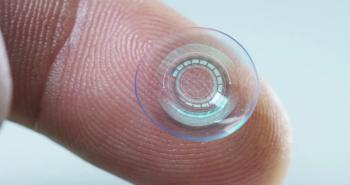
AAOpt 2023: Favorable data on corneal staining
Using the NEI protocol for addressing corneal staining, researchers used 5 microliters of 2%, non preserved fluorescein and then evaluated corneal staining.
Ahmad M. Fahmy, OD, FAAO, Dipl. ABO, sat down with Optometry Times®' assistant managing editor Emily Kaiser Maharjan to share favorable data on corneal staining, which he presented during the 2023 American Academy of Optometry meeting in New Orleans.
Editor's note: This transcript has been edited for clarity.
Emily Kaiser Maharjan:
Hi everyone. I'm here with Dr. Ahmad Fahmy, who is here to talk about his AAOpt poster on an eye drop for dry eye disease that reduces corneal staining across all regions of the cornea. Welcome, Dr. Fahmy; I'm so glad you could join us.
Ahmad M. Fahmy, OD, FAAO, Dipl. ABO:
Hi, thank you for having me.
Kaiser Maharjan:
Can you tell me more about what you presented at AAOpt?
Fahmy:
Yeah, so I had the honor of presenting a poster on—it's a novel new medication, or eye drop, it's perfluorohexyloctane, it's a semifluorinated alkane, and we looked at its effect on corneal staining after using it QID for an 8 week period and compared that to a placebo group.
Kaiser Maharjan:
Fantastic. And can you tell me a little bit about what this research will mean for patients?
Fahmy:
Absolutely. So it was really favorable. We use the NEI protocol for assessing corneal staining. So we use 5 microliters of 2%, non preserved fluorescein and then looked at corneal staining. So it was really interesting that total corneal staining improved twofold, central corneal staining improved four fold, and inferior corneal staining improved 2.5 fold.
So the relevance, of course, of all of that is that a lot of our patients really struggle with ocular surface disease symptoms, and at the heart of that is this hyper evaporative tear film—or an evaporative component. So that's what this molecule really specifically addressed. And those specific regions of the cornea are really at the heart of a lot of, again, a patient's symptoms.
A lot of patients sometimes will come in saying, "My main thing is that I have a lot of variability in my vision." And so that's related to that central corneal staining, and a lot of our other patients might come in saying, "Well, my eyes really kind of bothered me more after I've been using the computer for about an hour," because of that decreased blink rate, and those patients usually have this inferior band of corneal staining.
So for us clinicians to really see this very specific data and in the significant improvement was really favorable.
Kaiser Maharjan:
Absolutely. And in your opinion, what is the future of dry eye disease therapy?
Fahmy:
I mean it's so exciting. There's a lot of innovation in ocular surface disease. And it really is one of the more meaningful things that we can offer our patients, especially as doctors of optometry, and those of us that really specialize in ocular surface diseases. How do we figure out how to improve the quality of life of those patients that are refractory to some of the things that we're already offering them.
And there's just a lot of innovation and a lot of different medications that are being examined right now. And so now we have a lot more solutions than we did even a couple of years ago. So to be able to really dig into the science and the data, and confidently be able to offer that to our patients. It's really exciting.
Kaiser Maharjan:
Absolutely. I could not agree more. And is there anything else that you'd like to mention that we haven't touched on?
Fahmy:
I think that, again, it's an exciting time, and I was really honored to be able to present this really favorable data. And thank you for joining us.
Kaiser Maharjan:
Absolutely. Well, thank you so much for taking the time to chat today, Dr. Fahmy; it's been an absolute delight to hear more about this molecule and dry eye disease and what's coming down the pike. So thank you so much.
Fahmy:
My pleasure. Anytime.
Newsletter
Want more insights like this? Subscribe to Optometry Times and get clinical pearls and practice tips delivered straight to your inbox.















































